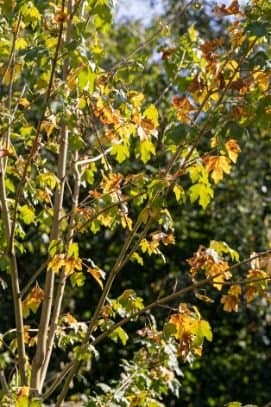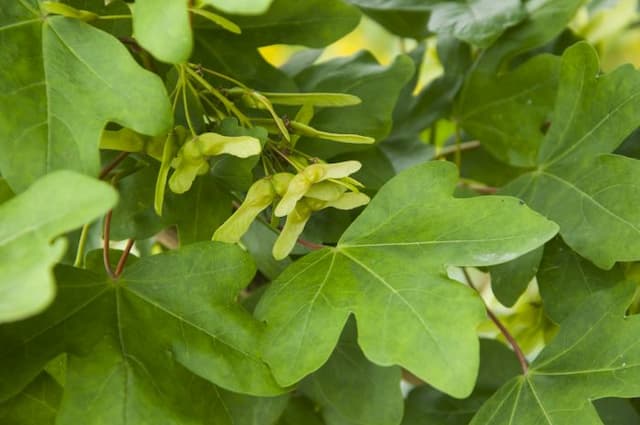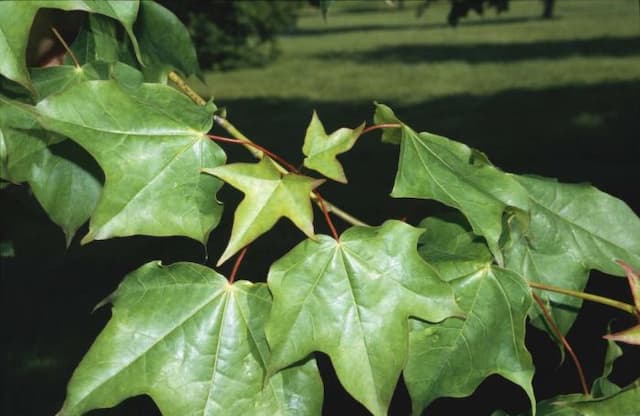Japanese Maple Acer palmatum 'Osakazuki' (A)

ABOUT
Japanese Maple 'Osakazuki' is a stunning deciduous tree known for its deeply lobed, palmate leaves which present a striking appearance throughout the seasons. In spring, the foliage emerges a bright green color, offering a lush and vibrant display. As the tree matures through the growing season, these leaves harden off to a deeper green, providing a dense, leafy canopy with a soft, layered texture. The true spectacle of the Japanese Maple 'Osakazuki' emerges in the fall when it boasts one of the most brilliant autumn color displays among the maples. The leaves transform into a fiery spectacle of vibrant red, sometimes with an almost glowing intensity, making the tree a standout in any landscape. This radiant fall color is one of the defining features of 'Osakazuki' and is highly sought after by gardeners and landscapers. The overall shape of the tree is typically rounded to vase-like, with a gracefully spreading canopy that creates an elegant silhouette against the sky. The fine branching structure adds to its exquisite appearance, becoming especially prominent in winter when the leaves have fallen. The bark of the Japanese Maple 'Osakazuki' is smooth and gray, providing a subtle but attractive contrast to the colorful foliage throughout the year. Even without leaves in the dormant season, the intricate branch patterns and the texture of the bark offer visual interest. In terms of texture, the foliage is relatively soft to the touch, and the leaves are arranged in a way that gives the canopy a full and lush look. The juxtaposition of the soft foliage against the harder bark adds another layer of textural interest to the tree's aesthetic. Flowers and seeds of the Japanese Maple 'Osakazuki' are generally inconspicuous compared to the striking foliage, with small and somewhat delicate flowers giving way to the typical winged maple seeds, called samaras, which can often be seen twirling to the ground in the breeze. Overall, the Japanese Maple 'Osakazuki' offers a year-round display of beauty through its ever-changing leaves, graceful form, and textured bark, making it a cherished specimen in gardens that are designed for visual impact across the seasons.
About this plant
 Names
NamesFamily
Sapindaceae
Synonyms
Japanese Maple, Osakazuki Japanese Maple, Osakazuki Maple
Common names
Acer palmatum 'Osakazuki'
 Toxicity
ToxicityTo humans
The Japanese Maple is generally not considered toxic to humans. There is little evidence of serious toxicity and no common symptoms associated with ingestion of this plant's parts. However, as with any plant, individual allergies or sensitivities could potentially cause mild stomach upset or dermatitis in some people.
To pets
The Japanese Maple is also not considered toxic to pets. It should not cause serious harm if pets happen to ingest its leaves or bark. As with any non-food item, if consumed in large quantities, it could potentially cause a mechanical blockage or mild gastrointestinal upset, but toxicity is not a common concern with this plant.
 Characteristics
CharacteristicsLife cycle
Perennials
Foliage type
Deciduous
Color of leaves
Green
Height
20 feet (6 meters)
Spread
20 feet (6 meters)
Plant type
Tree
Hardiness zones
5
Native area
Japan
Benefits
 General Benefits
General Benefits- Stunning Fall Color: Osakazuki Japanese Maple is renowned for its vibrant, fiery red foliage in autumn, providing a dramatic display.
- Ornamental Foliage: Its delicate, palmate leaves offer visual interest from spring through fall with changing colors.
- Compact Size: It is a relatively small tree, making it suitable for smaller gardens and spaces.
- Shade Provider: The canopy of the tree offers shade in garden settings, making it a functional as well as decorative plant.
- Seasonal Interest: It provides year-round interest with its changing leaf colors, attractive bark in winter, and a graceful structure.
- Low Maintenance: Once established, it requires minimal upkeep beyond occasional pruning to maintain its shape and health.
- Wildlife Habitat: The tree can serve as a habitat and food source for various bird species, adding to biodiversity.
- Garden Focal Point: Its distinctive look and color make it an excellent focal point in landscape design.
- Increases Property Value: Landscaping with distinctive trees like the Osakazuki Japanese Maple can increase the aesthetic and market value of a property.
- Cultural Significance: The species is often associated with Japanese gardens and can imbue a space with a sense of cultural or Zen-like quality.
 Medical Properties
Medical PropertiesThis plant is not used for medical purposes.
 Air-purifying Qualities
Air-purifying QualitiesThis plant is not specifically known for air purifying qualities.
 Other Uses
Other Uses- Miniature Bonsai: Japanese maple trees like 'Acer palmatum 'Osakazuki'' are commonly used for creating bonsai due to their small leaves and attractive branch structures.
- Photography Backdrop: The vivid colors of the Japanese maple in autumn provide a beautiful backdrop for photographers, especially during the fall season.
- Artistic Inspiration: Artists may use the striking appearance of the Japanese maple's foliage and form as inspiration in painting, drawing, or digital art.
- Theme Gardens: Japanese maples can be used in Japanese-themed gardens to add authenticity and harmony with other Asian plant species.
- Culinary Garnish: While not commonly eaten, the delicate leaves of the Japanese maple can be used as an ornamental garnish for specialty dishes at high-end restaurants.
- Leaf Castings: The intricate leaves of the Japanese maple can be used to make decorative leaf castings for use in art projects or home décor.
- Education: Japanese maples can be used as a teaching tool for botany and horticulture classes, demonstrating plant growth patterns and seasonal changes.
- Mood Enhancer: The calming effect of the Japanese maple's gentle form and color transitions can be utilized in therapeutic gardens or landscapes designed for relaxation.
- Landscape Design: With their dramatic seasonal color change, Japanese maples are used to create focal points or to enhance the aesthetic appeal in landscape design.
- Feng Shui: In feng shui, the Japanese maple is sometimes planted to balance the flow of energy in a garden, believed to bring positive effects to the household.
Interesting Facts
 Feng Shui
Feng ShuiThe Japanese Maple is not used in Feng Shui practice.
 Zodiac Sign Compitability
Zodiac Sign CompitabilityThe Japanese Maple is not used in astrology practice.
 Plant Symbolism
Plant Symbolism- Peace - Japanese Maple, particularly the 'Osakazuki' cultivar, is native to Japan, a country that often associates its flora with tranquility and calmness.
- Elegance - The fine, delicate leaves of the Japanese Maple signify grace and sophistication, which the 'Osakazuki' exemplifies with its exceptional fall colors.
- Beauty - 'Osakazuki', known for its stunning scarlet leaves in autumn, is a symbol of natural beauty in the changing seasons.
- Balance - The balanced, symmetrical growth habit of 'Osakazuki' Japanese Maple represents harmony and equilibrium.
- Endurance and Change - As a deciduous tree that undergoes a remarkable transformation every year, the Japanese Maple 'Osakazuki' symbolizes the ability to endure and adapt to change.
 Water
WaterThe Japanese Maple should be watered deeply and regularly, providing about 1-2 inches of water per week. During hot or dry spells, increase watering to twice a week, ensuring that the soil stays moist but not waterlogged. It’s essential to avoid overhead watering to prevent leaf scorch and instead use a soaker hose or drip irrigation to apply water directly to the root zone. Adjustments should be made for rainfall, and during the winter months, reduce watering as the tree's water requirements decrease.
 Light
LightThe Japanese Maple thrives in a spot with full sun to partial shade. It is optimal to provide morning sun and afternoon shade, especially in hot climates, to protect the delicate leaves from harsh sun exposure. Filtered sunlight is ideal to bring out the vibrant colors of the foliage without causing leaf burn.
 Temperature
TemperatureThe Japanese Maple does best in temperatures ranging from 20 to 85 degrees Fahrenheit. It can survive minimum winter temperatures down to 0 degrees Fahrenheit, but young trees may need some protection. Optimal growth occurs when the temperatures are consistently within the 60 to 70 degrees Fahrenheit range.
 Pruning
PruningPruning the Japanese Maple is mainly for aesthetic shaping and should be done in late winter or early spring before sap begins to flow. Thinning out crowded branches allows light into the tree's center, promoting a healthier structure. Removal of dead or damaged wood can be performed anytime, but major pruning should be limited to once a year during dormancy.
 Cleaning
CleaningAs needed
 Soil
SoilThe ideal soil mix for Japanese Maple 'Osakazuki' is well-draining, composed of 1/3 peat, 1/3 pine bark, and 1/3 coarse sand or perlite. The soil pH should be slightly acidic, around 5.5 to 6.5.
 Repotting
RepottingJapanese Maple 'Osakazuki' should generally be repotted every 2-3 years, or when it becomes root-bound, to ensure it continues to thrive.
 Humidity & Misting
Humidity & MistingJapanese Maple 'Osakazuki' prefers moderate humidity levels but is adaptable to the typical outdoor range without requiring specific humidity adjustments.
 Suitable locations
Suitable locationsIndoor
Place in bright, indirect light with adequate airflow for indoor cultivation.
Outdoor
Ensure full sun to partial shade, shelter from strong winds.
Hardiness zone
5-8 USDA
 Life cycle
Life cycleAcer palmatum 'Osakazuki', commonly known as Japanese Maple, begins its life cycle as a seed, which after stratification germinates in spring under the right conditions of warmth and moisture. The seedling stage follows, where the young maple develops its initial root system and a pair of true leaves, and over several years, it grows into a sapling as it establishes more extensive roots and begins to develop its characteristic leaf shape. As it matures into an adult tree, the Japanese Maple experiences a period of vegetative growth each year, where it produces its deeply lobed leaves that turn a vibrant red in the fall. During the reproductive stage, which may occur after several years of growth, the tree bears small purple flowers that are followed by the production of winged samaras, or seed pods, that disperse in the wind for propagation. The mature Japanese Maple can live and continue its reproductive cycle for decades, weathering the seasons, until it eventually reaches senescence, when growth slows, and it may become more susceptible to environmental stresses, pests, or diseases, leading to its eventual decline and death.
 Propogation
PropogationPropogation time
Spring-Early Summer
The most popular method for propagating the Japanese Maple 'Osakazuki' is by softwood cuttings. This is typically done in early summer when new growth is still flexible but starting to mature. A cutting of about 4 to 6 inches (10 to 15 cm) is taken, making sure it includes at least two sets of leaves. The bottom set of leaves is removed, and the cut end is dipped into a rooting hormone to encourage root development. The prepared cutting is then placed into a well-draining potting mix and kept moist under high humidity, often with the aid of a plastic cover or propagation chamber. Roots generally begin to form within a few weeks, after which the cutting can gradually acclimate to less humid conditions before eventual planting out.







![Freeman maple [Autumn Blaze]](/_next/image?url=https%3A%2F%2Fplants-admin.emdemapps.com%2Fimages%2Fplants%2F%2Fimages%2F604b575b84d87.png&w=640&q=75)

